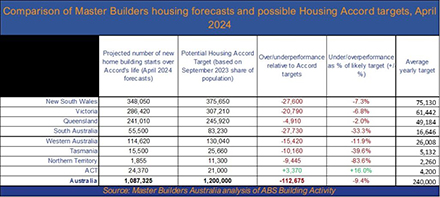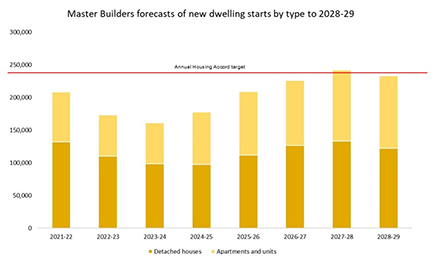Despite a myriad of Federal Government housing initiatives, Australia is on track to fall over 110,000 homes short of its National Housing Accord target. Source: Timberbiz
Master Builders Australia has released its 2024 building and construction industry forecasts which, for the first time, cover the full five-year period of the Accord.
From 1 July 2024 until 30 June 2029, Master Builders forecasts 1,087,325 new home starts.
Master Builders Chief Economist Shane Garrett said work started on just 163,285 new homes during 2023, a 10.5% reduction on the previous year.
“During 2023, detached house starts dropped by 16.4% to 99,443. This is the lowest in a decade.
“The final three months of the 2023 quarter saw higher density home starts drop for the third consecutive quarter.
“A total of 62,720 higher density homes were commenced during 2023 overall – the worst performance in 12 years.
“The mismatch between the supply of new homes to the rental market and demand for rental accommodation is particularly worrying.
“Rental inflation continues to accelerate at a time when price pressures across the rest of the economy have been abating,” Mr Garrett said.
Master Builders CEO Denita Wawn said that we were seeing inflation starting to near its target range and we can expect a fall in interest rates which will lead to a more favourable investment market.
“The Federal Government has also announced a number of significant housing measures that focus on increasing supply in social and affordable housing and the rental market.
“However, constraints on the supply side like workforce shortages, industrial relations changes and a poor planning system counter the full effectiveness of these measures,” Ms Wawn said.
“Productivity in the industry has fallen 18% over the last decade. It’s clear that governments need to expedite the rollout of planning reforms to reduce the high costs and time it takes to build.
“Concerningly, the full impact of the Closing Loopholes Bills and union pattern bargaining negotiations underway in several states has not been factored into these forecasts.
“Workforce shortages continue to be the biggest challenge for the industry across all sectors.
“At a federal level, the government’s priority should be growing the building and construction workforce.
“We heard only recently from BuildSkills Australia that the industry needs 90,000 workers in the next 90 days.
“Domestically, we cannot fill this gap. We need to think outside of the box with better apprenticeship incentives, reskilling migrants already in Australia, and a targeted international campaign to bring in skilled migrants.
“Investment and support in the whole built environment is important. While the commercial and civil construction sectors have helped shield the economy from periods of negative economic growth, this is coming to an end.
“We can’t build the homes we need without the appropriate commercial and civil infrastructure to support it. This includes critical infrastructure such as utilities.
“Builders are up to the challenge to reach these targets but the barriers on the road need to be cleared to get the job done,” Ms Wawn said.
Full forecasts can be purchased here: https://masterbuilders.com.au/product-category/forecasts/








